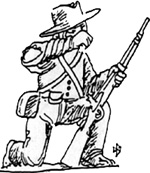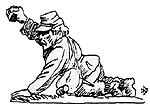 The first surprise with this rule set occurs when you open the box. Inside is the set of master rules, the supplement rules, Impetus Clock Display, two master player aid cards, two period specific player aid cards, a deck of army characterisation cards, two Sequence Decks, a pack of multi-sided dice, a bag of morale chips [white metal], a bag of status markers [white metal], and a command caliper. You still need a yard stick, a photcopy of the Army Characteristics Record, and of course your miniature warriors to play but as games packages go this is the most complete one I have seen so far.
The first surprise with this rule set occurs when you open the box. Inside is the set of master rules, the supplement rules, Impetus Clock Display, two master player aid cards, two period specific player aid cards, a deck of army characterisation cards, two Sequence Decks, a pack of multi-sided dice, a bag of morale chips [white metal], a bag of status markers [white metal], and a command caliper. You still need a yard stick, a photcopy of the Army Characteristics Record, and of course your miniature warriors to play but as games packages go this is the most complete one I have seen so far.
The next surprise happens when you read through for the first time. This is when you discover that these rules are radically, and I mean radically, different! All the rule sets I have used over the last twenty years have been based on the standard principle of 'A' player turn of phases followed by 'B' player turn of phases. This standardisation of operation tends to impart predictability into the games, permitting decisions and actions a commander of the period would not have possessed.
As a solo gamer I have spent many hours building mechanisms for commander profiles, troop quality, morale ratings, weaponry ratings, chance cards etc. trying to bring some measure of unpredicatability or, if you prefer, 'fog of war' into my games. Here is a rule set containing this already and more besides.
When you build your troop lists you are referred to the Card Divisor Table [CDT] which gives details of the overall percentages for differing unit types. Having done a few comparisons with my own figures for specific battles the ACW table appears fine, splitting by year of the war and theatre of operations.
Having decided your force composition and unit types, listing them on the ACR (Army Characterisitics Record), you then start applying ratings, commencing at the top with the C-in-C. His is a significant rating which directly affects command radius, the contents of the sequence deck, and his ability to help his sub-commanders. Next you rate the sub-commanders and determine their command radius and quality.
This is followed by applying a battle quality rating to the units with adjustments for weapons and type. After all of this you now have an army whose command capability and troop capabilities have been decided, not by you but by die rolls. All you have to do is fight the battle with it.
To add a little more uncertainty, you reference the CDT for the appropriate divisor for the particular year and theatre and divide your total number of units by it. This is the number of cards you deal from the ACD (Army Characterisation Deck). This supplies your army with special abilities, special troops, strategies and most importantly supplies the armies morale chip count. You need at least one chip per unit so any shortfall first loses the specialist cards replaced from the deck with numbered cards hopefully. If you still have a shortfall then you lose units - they decided not to play after all. You do get additions during play for routed units etc. but without them your actions become decidedly restricted. Eventually the only recourse is retreat so do not waste them.
Now we come to what I consider to be the best component in the rule set, the sequence deck. In ACW the basic deck is thirty cards the makup varying by year and theatre with up to 18 optional cards as well. The composition of this deck is primarily dictated by Sequence Decks tables which reflect the year and theatre of operations . It is further affected by the loss of officers, the C-in-C rating, when the C-in-C takes direct command. This is the deck you shuffle and use in the turns. Its rather like the chance cards solists use but significantly more sophisticated and comprehensive.
Each turn consists of a variable number of phases where a D20 [Command Die] is rolled by each side, the higher score having the initiative [termed Impetus], the difference is how many action points [Impetus Points] are available for use. Each impetus point allows the turning of a sequence deck card. You get to choose which command group is to act on the card. If you have no further use for the card, then you discard it and turn over another as long as you have impetus left. A turn ends after twenty impetus have been generated, a sequence deck is exhausted, or you both roll the same die value. Then the decks are shuffled and you start again, but this is an over simplification; there really is much more to it than that.
I have obviously only used the tables for ACW but the supplement also covers Maximillian in Mexico 1862-1867, Austro-Prussian War 1866, and the Franco-Prussian War 1870-1871. Not having researched these I cannot comment on the accuracy of the tables except to say they appear every bit as detailed as the ACW.
To summarise then, these rules are a radical departure from the standard. This will no doubt upset some gamers, especially, I imagine, the rule lawyers, but ultimately we are all individuals with our own views and opinions. I firmly believe these rules with their modular construction offer the gamer, especially the solo gamer, a whole new vista of opportunities and new set of challenges.
 Perhaps more importantly, to me at least, they have injected a new vitality into my miniature gaming - I am now on a new learning curve and enjoying every minute. They force you to really think, to be decisive, commit you forces, attempt control in changing circumstances, and still strive to achieve that objective. Indecision and bad planning cost, you have to prioritise your unit actions, decide where the critical action is, and go for it. You must learn to leave other command groups, not central to your goal, to do the best they can. Predictability is gone; you operate on incomplete knowledge - rather as the actual commanders did, without really knowing what action or circumstance will occur next. If your plan is bad, then watch your army disintegrate because you got it wrong.
Perhaps more importantly, to me at least, they have injected a new vitality into my miniature gaming - I am now on a new learning curve and enjoying every minute. They force you to really think, to be decisive, commit you forces, attempt control in changing circumstances, and still strive to achieve that objective. Indecision and bad planning cost, you have to prioritise your unit actions, decide where the critical action is, and go for it. You must learn to leave other command groups, not central to your goal, to do the best they can. Predictability is gone; you operate on incomplete knowledge - rather as the actual commanders did, without really knowing what action or circumstance will occur next. If your plan is bad, then watch your army disintegrate because you got it wrong.
I can readily testify to something of a culture shock the first time I played but I am adjusting with each game. When I re-fought a battle from my ACW campaign the easy victory became a draw, but I take full responsibility for the commander's lack of planning; I was the commander. So if you fancy a radical departure from the standard rule format and like new challenges, then I can certainly recommend these rules.
[Piquet will be available through Bryan Ansell. The "deluxe" version will be £30 postpaid to England. The "UK" version (un-boxed in Ziplock Bag, no dice, uncut cards, no metal or plastic parts.) will be £20.50 Postpaid to England. We are currently in discussions for group deal for SWA members, at time of writing.]
Another Piquet Review (Napoleonic)
Back to Table of Contents -- Lone Warrior #120
Back to Lone Warrior List of Issues
Back to MagWeb Magazine List
© Copyright 1997 by Solo Wargamers Association.
This article appears in MagWeb (Magazine Web) on the Internet World Wide Web.
Other military history articles and gaming articles are available at http://www.magweb.com
